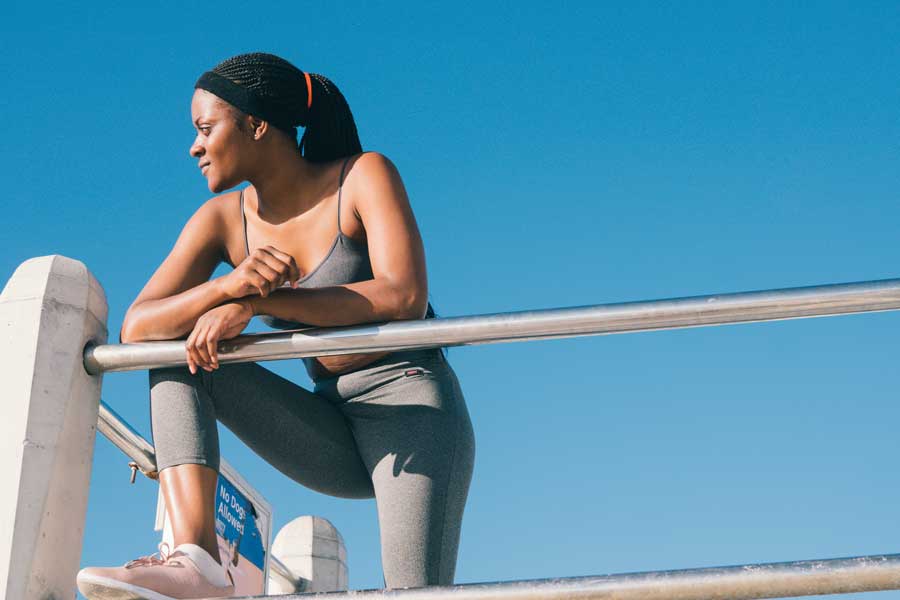
Everyone knows that poor posture looks pretty terrible. However bad posture can also do a lot more damage to your overall health than you realise.
Biomechanics pioneer Dell-Maree Day says many people’s bones are out of alignment due to poor posture – particularly as we all seem to be looking down at electronic screens nowadays- causing muscles to sit incorrectly which can then lead to other health problems.
The Sydney-based former Pilates instructor is the creator of a unique online programme called The Invisible Exercise (TIE) which over a course of 10 weeks shows you how to correctly use all 639 muscles in your body by mastering 10 key poses that’ll realign your body.
“Strengthening your body through posture exercises will improve your entire system,” says Dell-Maree. “The poorer your posture, the more your body will struggle to work efficiently as bunching and hunching will restrict how well your body oxygenates and functions as a whole. This can lead to issues such as muscular-skeletal problems and can leave you more susceptible to injury when moving.”
In TIE, Dell-Maree teaches people how to start conditioning their entire body first by triggering “muscle memory” before they can then focus further on trouble spots such as their abs or back. “All it takes to fire up ‘muscle memory’ – that is, the way muscles are supposed to naturally sit in their best possible capacity – is getting our bones into the right position through posture training. This creates a chain reaction, making the connective tissue lift muscle onto bone correctly which then improves your shape.”
Additionally, Dell-Maree says you can do a lot to correct your posture on a day-to-day basis by simply learning how to do things like sitting and standing properly which will improve the way you look and feel.
“I say to people you don’t necessarily need to race off to the gym to start getting fit. The most effective posture training requires you to remain as still as possible. Whilst it may look like you’re not doing much, and that any exercise is ‘invisible’, in fact your body is burning serious calories as it stretches and retrains itself.”
Master these postures and see the difference it makes to how you look and feel.

1. The sitting posture
Try this: Move your spine away from the back of your chair and sit towards the front half of the chair. Place your feet flat on the floor with a fist-size space between your feet and knees.
Look straight ahead and sit as tall and relaxed as possible. Check your arms are relaxed. I also advise people to exercise their breathing muscles around their ribs and sternum whilst sitting. Breath in through your nose and help your body breathe out by blowing gently through your lips. Think this thought: ‘sternum straight through to spine’. This thought will help your mind alert your body to create a new ‘muscle memory’ of correctly aligning your spine.
What it does: Your spine will be stacking itself up so the natural curves of your back will have improved and your upper back muscles will be in alignment. This sitting posture will also help flatten and lengthen your abs as you pull your body upwards..
2. The standing posture
Try this: When standing still, aim to look straight ahead with your feet 10cm apart. Stand as tall as relaxed as possible. Since the advent of smart phones, the standing posture for many has really gone downhill as people are now looking down constantly at their phones, pulling their neck muscles forward and giving themselves a hunch back. Always look ahead if you can.
What it does: Your shoulders, upper and lower back will lift and relax better in this position, reducing strain in areas such as your neck and upper torso.
3. The walking posture
Try this: Walk looking straight ahead in a relaxed manner and straighten up to your tallest height. Take the longest stride you can without lapsing into a “silly walk”! Whilst re-aligning your body with “still postures” is more effective, it’s still a nice idea to practice good posture when walking.
What it does: The longer your stride, the more you’re extending and flexing your hamstrings. The tighter your hamstrings the more your spine will be pulled forwards.
4. The resting face posture
Try this: The first thing to remember is to always try to look straight ahead wherever possible so your neck is straight and your jaw is not tilted forward. If you are working at your computer, especially if it’s a laptop, try to elevate it so your eyes rest on the top third of the screen. Make sure your jaw is not too close to your throat and not too far away. When in resting mode, your facial and neck muscles should always be relaxed and not clenched. Also smile as much as you can to lift the area around the lower face!
What it does: Looking straight ahead prevents your jowls from falling forward and strengthens your neck muscles.
5. The stretching posture
Try this: When you wake up, or whenever you need a burst of energy, have a good stretch. Stand and raise your arms straight up to the ceiling with your fingers pointed. Your arms should be the natural width of your shoulders apart. Stretch up as tall as you can keeping your feet flat on the ground. Remain in the stretch position for a few seconds.
What it does: This can help open up your chest and get your breathing muscles activated, alleviating any tightness in the area.
Writer: Fleur Michell
To learn more about the 10 master poses outlined in Dell-Maree’s The Invisible Exercise program, visit theinvisibleexercise.com.au


